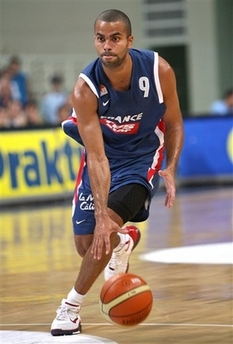The NBA is changing the way teams are seeded in the postseason, looking to
avoid the controversy that surrounded last season's playoffs.

Tony Parker of France, dribbles the
ball during the Acropolis Basketball tournament, in Athens' Olympic
stadium , Greece, Wednesday, Aug. 2 , 2006 . NBA's San Antonio Spurs
player was a top scorer of the
tournament.[AP] |
Under the change, the
top four seeds ¡ª the three division winners and the second-place team with the
best record ¡ª will be seeded according to their win-loss total, guaranteeing
that the top two teams in each conference can't meet until the conference
finals, the league announced Wednesday.
"I think it's a tweak, is what I'd call it, and it's probably a good one,"
said Jerry Colangelo, the former chairman of the league's Board of Governors.
"Ultimately you want your best teams, the teams who have worked all season to
put themselves in a position based on their records, to be seeded accordingly."
The NBA had given the top three seeds to division winners regardless of
record, meaning a second-place team could not do better than the No. 4 seed,
even if it had a better record than a division champion.
That rule came under fire last season when division rivals San Antonio and
Dallas met in the second round of the Western Conference playoffs, even though
the second-place Mavericks had a far better record than division champions
Phoenix or Denver.
Dallas knocked off the first-place Spurs in a thrilling matchup of 60-game
winners, capturing Game 7 on the road in overtime.
"It may have been mentioned in the past, but this year just because of the
Dallas-San Antonio situation it kind of brought it to a head," Colangelo said.
"So it was discussed in the second half of the year."
The Board of Governors also voted to expand the postseason rosters to 15,
instead of 13, with 12 players active for each game. That duplicates the rule
used in the regular season.
The NBA champion Miami Heat were among those that criticized the policy that
forced teams to carry fewer players in the playoffs than during the season.
Also, if a team has two 60-second timeouts left in the final 2 minutes of
regulation or in overtime, one will be reduced to a 20-second timeout. Teams
will now have two 60-second timeouts and one lasting 20 seconds in overtime,
instead of three 1-minute timeouts. Clubs will no longer be permitted to carry
over a 20-second timeout from regulation into overtime.
"Our owners are intent on making the playoff seeding more fair for all teams
going forward and in quickening the pace of the end of games," NBA executive
vice president Stu Jackson said in a statement. "The board also thought it made
sense to allow teams to utilize the same 15-man roster in the playoffs that they
use during the regular season."